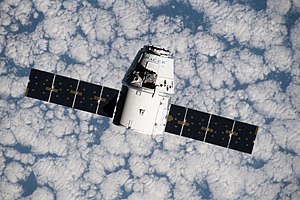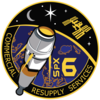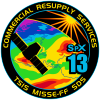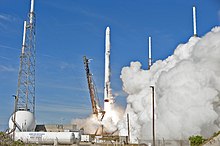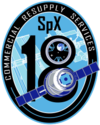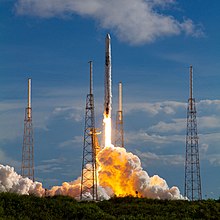
The SpaceX Dragon, also known as Dragon 1 or Cargo Dragon and now superseded by Dragon 2, is a reusable cargo spacecraft developed by SpaceX, an American private space transportation company. Dragon was launched into orbit by the company's Falcon 9 launch vehicle to resupply the International Space Station (ISS).

Commercial Resupply Services (CRS) are a series of flights awarded by NASA for the delivery of cargo and supplies to the International Space Station (ISS) on commercially operated spacecraft. The first CRS contracts were signed in 2008 and awarded $1.6 billion to SpaceX for twelve cargo Dragon and $1.9 billion to Orbital Sciences for eight Cygnus flights, covering deliveries to 2016. The Falcon 9 and Antares rockets were also developed under the CRS program.

SpaceX COTS Demo Flight 1 was the first orbital spaceflight of the Dragon cargo spacecraft, and the second overall flight of the Falcon 9 rocket manufactured by SpaceX. It was also the first demonstration flight for NASA's Commercial Orbital Transportation Services (COTS) program. The primary mission objectives were to test the orbital maneuvering and reentry of the Dragon capsule. The mission also aimed to test fixes to the Falcon 9 rocket, particularly the unplanned roll of the first stage that occurred during flight 1. Liftoff occurred on 8 December 2010 at 15:43 UTC.
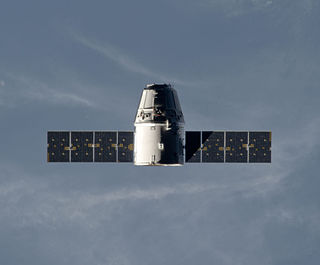
SpaceX CRS-1, also known as SpX-1, was the third flight for Space Exploration Technologies Corporation's (SpaceX) uncrewed Dragon cargo spacecraft, the fourth overall flight for the company's two-stage Falcon 9 launch vehicle, and the first SpaceX operational mission under their Commercial Resupply Services contract with NASA. The launch occurred on 8 October 2012 at 00:34:07 UTC.

SpaceX CRS-3, also known as SpX-3, was a Commercial Resupply Service mission to the International Space Station, contracted to NASA, which was launched on 18 April 2014. It was the fifth flight for SpaceX's uncrewed Dragon cargo spacecraft and the third SpaceX operational mission contracted to NASA under a Commercial Resupply Services contract.

SpaceX CRS-8, also known as SpX-8, was a Commercial Resupply Service mission to the International Space Station (ISS) which was launched on April 8, 2016, at 20:43 UTC. It was the 23rd flight of a Falcon 9 rocket, the tenth flight of a Dragon cargo spacecraft and the eighth operational mission contracted to SpaceX by NASA under the Commercial Resupply Services program. The capsule carried over 3,100 kilograms (6,800 lb) of cargo to the ISS including the Bigelow Expandable Activity Module (BEAM), a prototype inflatable space habitat delivered in the vehicle's trunk, which will be attached to the station for two years of in-orbit viability tests.

SpaceX CRS-4, also known as SpX-4, was a Commercial Resupply Service mission to the International Space Station, contracted to NASA, which was launched on 21 September 2014 and arrived at the space station on 23 September 2014. It was the sixth flight for SpaceX's uncrewed Dragon cargo spacecraft, and the fourth SpaceX operational mission contracted to NASA under a Commercial Resupply Services contract. The mission brought equipment and supplies to the space station, including the first 3D printer to be tested in space, a device to measure wind speed on Earth, and small satellites to be launched from the station. It also brought 20 mice for long-term research aboard the ISS.

Dragon 2 is a class of reusable spacecraft developed and manufactured by American aerospace manufacturer SpaceX as the successor to the Dragon 1 cargo spacecraft. It has two variants: Crew Dragon, a human-rated capsule capable of ferrying up to seven astronauts, and Cargo Dragon, an updated replacement for the original Dragon spacecraft. The spacecraft launches atop a Falcon 9 Block 5 rocket and returns to Earth via an ocean splashdown. Unlike its predecessor, the spacecraft can dock itself to the ISS instead of being berthed. Crew Dragon is equipped with an integrated launch escape system (LES) capable of accelerating the vehicle away from the rocket in an emergency at 11.8 m/s2, accomplished by using a set of four side-mounted thruster pods with two SuperDraco engines each. The spacecraft features redesigned solar arrays and a modified outer mold line compared to the original Dragon, and possess new flight computers and avionics. As of March 2020, four Dragon 2 spacecraft have been manufactured ; a test article named Dragonfly and three flightworthy vehicles, one of which was destroyed in an engine test.

SpaceX CRS-10, also known as SpX-10, was a Dragon Commercial Resupply Service mission to the International Space Station (ISS) which launched on 19 February 2017. The mission was contracted by NASA as part of its Commercial Resupply Services program and was launched by SpaceX aboard the 30th flight of the Falcon 9 rocket. The mission ended on 19 March 2017 when the Dragon spacecraft left the ISS and safely returned to Earth.

SpaceX CRS-11, also known as SpX-11, was a Commercial Resupply Service mission to the International Space Station, launched successfully on 3 June 2017. The mission was contracted by NASA and was flown by SpaceX. The mission utilized a Falcon 9 launch vehicle and was the first reuse of C106, a CRS Dragon cargo vessel that was previously flown on the CRS-4 mission.

SpaceX CRS-12, also known as SpX-12, was a Commercial Resupply Services mission to the International Space Station launched on 14 August 2017. The mission was contracted by NASA and was flown by SpaceX using a new Dragon capsule. The Falcon 9 rocket's reusable first stage performed a controlled landing on Landing Zone 1 (LZ1) at Cape Canaveral Air Force Station. After delivering more than 2,900 kilograms (6,400 lb) of cargo, the Dragon spacecraft returned to Earth on 17 September 2017.

SpaceX CRS-13, also known as SpX-13, was a Commercial Resupply Service mission to the International Space Station launched on 15 December 2017. The mission was contracted by NASA and is flown by SpaceX. It was the second mission to successfully reuse a Dragon capsule, previously flown on CRS-6. The first stage of the Falcon 9 Full Thrust rocket was the previously flown, "flight-proven" core from CRS-11. The first stage returned to land at Cape Canaveral's Landing Zone 1 after separation of the first and second stage.

SpaceX CRS-14, also known as SpX-14, was a Commercial Resupply Service mission to the International Space Station launched on 2 April 2018. The mission was contracted by NASA and was flown by SpaceX. This mission reused the Falcon 9 first stage booster previously flown on CRS-12 and the Dragon capsule flown on CRS-8.

SpaceX CRS-15, also known as SpX-15, was a Commercial Resupply Service mission to the International Space Station launched 29 June 2018 aboard a Falcon 9 rocket. The mission was contracted by NASA and flown by SpaceX.

SpaceX CRS-16, also known as SpX-16, was a Commercial Resupply Service mission to the International Space Station launched on 5 December 2018 aboard a Falcon 9 rocket. The mission was contracted by NASA and is flown by SpaceX.

SpaceX CRS-18, also known as SpX-18, was SpaceX's 18th flight to the International Space Station under the Commercial Resupply Services program for NASA. It was launched on 25 July 2019 aboard a Falcon 9 rocket.

The SpaceX Dragon C106 is a Cargo Dragon space capsule built by SpaceX. It is the first reused SpaceX Dragon capsule to be reflown into space, having its second launch in 2017. C106 was first used on CRS-4, and then used again for the CRS-11 and CRS-19 missions. This third reuse of the spacecraft marks a milestone in SpaceX's drive to reduce space launch costs through reusing hardware.

SpaceX CRS-21, also known as SpaceX-21, is a Commercial Resupply Service mission to the International Space Station planned to be launched on 30 October 2020. The mission is contracted by NASA and will be flown by SpaceX using a Cargo Dragon. This will be the first flight for SpaceX under NASA's CRS-2 contract awarded in January 2016.

SpaceX CRS-22, also known as SpX-22, is a Commercial Resupply Service mission to the International Space Station planned to be launched on 12 March 2021. The mission is contracted by NASA and will be flown by SpaceX using a Cargo Dragon. This will be the second flight for SpaceX under NASA's CRS-2 contract awarded in January 2016.
